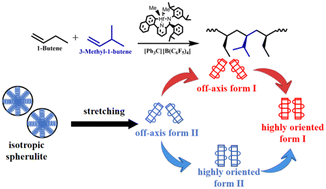Utilizing 3-methyl-1-butene co-units to tailor phase transition behavior in butene-1 copolymers†
Abstract
Copolymerization with extra co-units is often utilized to tailor the structure of crystalline polymers. In this work, a unique type of 3-methyl-1-butene (3M1B) co-monomer was chosen to introduce branched co-units into the polybutene-1 main chain. For this series of butene-1/3-methyl-1-butene random copolymers synthesized, the stretching-induced phase transition from the kinetically favored tetragonal form II into the thermodynamically stable trigonal form I was investigated using a combination of tensile tests and in situ wide-angle X-ray diffraction. The results revealed that for the II–I phase transition, not only the kinetics but also the orientation pathway shows strong dependence on the concentration of 3M1B co-units. For copolymer 3M1B1.27 with a low co-unit concentration of 1.27 mol%, form II transformed into form I as crystallites reached the off-axis orientation. With a high co-unit concentration of 3.12 mol%, form II of copolymer 3M1B3.12 could develop into a highly oriented state with c-axes parallel to the stretching direction, which subsequently transformed into highly oriented form I. More importantly, the stretching-induced II–I phase transition was suppressed by increasing 3M1B co-units of copolymers. Therefore, as the 3M1B co-unit concentration was increased in copolymers, the resistance to external deformation was decreased, resulting in decreased mechanical strength.



 Please wait while we load your content...
Please wait while we load your content...